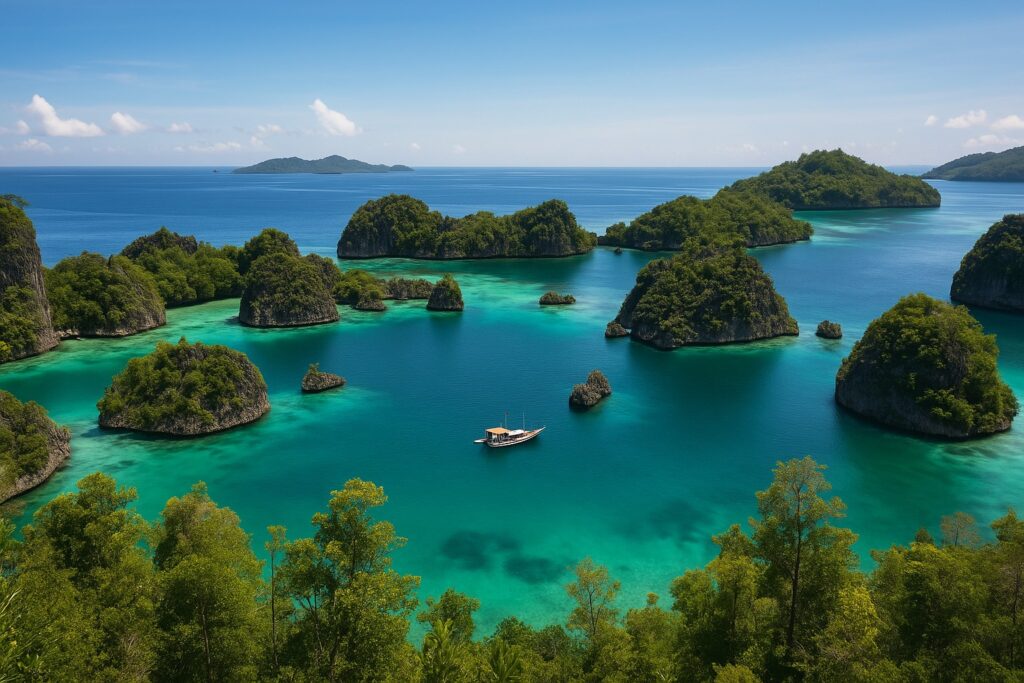Nestled off the northwest tip of Papua, Indonesia, Raja Ampat is often hailed as the last paradise on Earth
Nestled off the northwest tip of Papua, Indonesia, Raja Ampat is often hailed as the last paradise on Earth.Nestled off the northwest tip of Papua, Indonesia, Raja Ampat is often hailed as the last paradise on Earth.
Lees verder: Discover Raja Ampat: Paradise of IndonesiaKnown for its unmatched marine biodiversity, emerald karst islands, and crystal-clear waters, this archipelago remains one of the most pristine travel destinations in the world. In this ultimate 2025 travel guide, we’ll explore the best things to do, where to stay, how to get there, and why Raja Ampat deserves a top spot on your bucket list.
1. Why Raja Ampat Is So Special
Raja Ampat is part of the Coral Triangle and home to over 1,500 species of reef fish and 540 types of coral—making it the single most biodiverse marine ecosystem on Earth. The name “Raja Ampat” means “Four Kings,” referring to the four major islands: Misool, Salawati, Batanta, and Waigeo. These islands are surrounded by countless islets, lagoons, and secret beaches waiting to be explored.
But it’s not just the underwater world that makes Raja Ampat unique. The landscapes above water are equally stunning, with dramatic limestone cliffs, lush rainforests, and turquoise lagoons that are completely untouched by mass tourism.
2. How to Get to Raja Ampat
Reaching Raja Ampat is an adventure in itself. Here’s a typical route:
- Fly to Sorong (SOQ) – This is the nearest major airport, located in West Papua. You can fly from Jakarta, Bali, or Makassar.
- Ferry to Waisai – From Sorong’s harbor, take a public ferry to Waisai, the capital of Raja Ampat Regency on Waigeo Island.
- Local transfers – From Waisai, arrange speedboat transfers to your accommodation or island of choice.

3. Best Time to Visit Raja Ampat
The ideal time to visit Raja Ampat is October through April, during the dry season and when seas are calmest. For snorkelers and divers, this period offers the best underwater visibility and the highest chance to see manta rays, reef sharks, and turtles.
- October–December: Excellent visibility and rich marine life.
- January–March: Peak manta season, especially around Misool.
- May–September: Rainy season, rougher seas, many liveaboards don’t operate.
4. Top Things to Do in Raja Ampat
While diving is the main draw, Raja Ampat offers a wide range of unique and unforgettable experiences:
Island hopping – Explore stunning islets like Pianemo, Wayag, and Arborek.
Kayaking through lagoons – Paddle through karst caves, hidden coves, and vibrant mangroves.
Hike to Piaynemo Viewpoint – One of the most iconic viewpoints in Indonesia.
Snorkeling from your doorstep – Coral gardens are accessible right from beaches.
Visit local villages – Learn about Papuan traditions in places like Sawinggrai or Yenbuba.
Underwater photography – Perfect visibility and vibrant reefs make for spectacular shots.
5. Best Snorkeling and Diving Spots
Raja Ampat is a diver’s dream. Top dive and snorkel spots include:
- Cape Kri – Holds the world record for most fish species spotted in one dive (374!).
- Manta Sandy – A cleaning station for giant manta rays, best visited November to March.
- Blue Magic – Known for strong currents and pelagic encounters like tuna and barracuda.
- Misool Eco Resort House Reef – World-class reef with conservation efforts.
- Friwen Wall – Great for snorkelers with its shallow, colorful corals.
6. Wildlife and Nature on Land
While the underwater world steals the spotlight, Raja Ampat’s land-based wildlife is equally fascinating.
Birds of Paradise – Especially Wilson’s Bird of Paradise and Red Bird of Paradise. Tours depart early morning from Waigeo.
Monitor lizards, frogs, and endemic insects live in the lush forest.
Jungle trekking – Guided treks reveal medicinal plants, waterfalls, and spectacular viewpoints.
7. Where to Stay in Raja Ampat
Accommodation ranges from rustic eco-lodges to luxurious overwater bungalows. Popular options include:
- Misool Eco Resort (Misool) – Luxury eco-resort on a private island, committed to marine conservation.
- Papua Paradise Eco Resort (Birie Island) – Overwater bungalows and top-tier diving.
- Raja Ampat Biodiversity Resort (Waigeo) – Mid-range beachfront cottages, great snorkel reef.
- Homestays (Arborek, Kri, Gam) – Locally owned wooden huts offering authentic experiences and community support.

8. Responsible Travel and Conservation
Raja Ampat is a protected marine park, and it’s crucial to follow eco-friendly practices.
Pay the Marine Park Entry Fee: ~1,000,000 IDR (about €60) valid for 12 months.
Don’t touch coral or marine life.
Use only reef-safe sunscreen.
Bring your trash back—waste disposal is limited on remote islands.
Water is scarce—use sparingly.
By traveling responsibly, you help protect one of the most important ecosystems on Earth.
9. What to Pack for Raja Ampat
Raja Ampat is remote—come prepared. Essentials include:
Snorkel gear or dive mask
Reef-safe sunscreen & mosquito repellent
Water shoes or sandals
Dry bags for boat trips
Power bank (electricity may be limited)
Cash (ATMs are scarce)
Waterproof camera or GoPro
Lightweight, quick-dry clothing
Hat & sunglasses
10. Tips for Visiting a Remote Paradise
Internet is limited; many places have no Wi-Fi.
Bring enough cash—most islands are cash-only.
Be patient—transportation depends on tides, weather, and availability.
Learn a few words in Bahasa Indonesia to connect with locals.
Choose eco-certified operators to minimize your impact.
12. Final Thoughts
Raja Ampat is not the easiest destination to reach—but it is absolutely one of the most rewarding. With its vibrant marine life, breathtaking scenery, and quiet isolation, it offers a rare escape from the modern world. If you’re looking for a once-in-a-lifetime adventure, this is it.
Whether you’re a diver, a nature lover, or a curious traveler, Raja Ampat is the kind of place that leaves a lasting impression—and calls you back for more.


 Island hopping – Explore stunning islets like Pianemo, Wayag, and Arborek.
Island hopping – Explore stunning islets like Pianemo, Wayag, and Arborek. Kayaking through lagoons – Paddle through karst caves, hidden coves, and vibrant mangroves.
Kayaking through lagoons – Paddle through karst caves, hidden coves, and vibrant mangroves. Hike to Piaynemo Viewpoint – One of the most iconic viewpoints in Indonesia.
Hike to Piaynemo Viewpoint – One of the most iconic viewpoints in Indonesia. Snorkeling from your doorstep – Coral gardens are accessible right from beaches.
Snorkeling from your doorstep – Coral gardens are accessible right from beaches. Visit local villages – Learn about Papuan traditions in places like Sawinggrai or Yenbuba.
Visit local villages – Learn about Papuan traditions in places like Sawinggrai or Yenbuba. Underwater photography – Perfect visibility and vibrant reefs make for spectacular shots.
Underwater photography – Perfect visibility and vibrant reefs make for spectacular shots. Birds of Paradise – Especially Wilson’s Bird of Paradise and Red Bird of Paradise. Tours depart early morning from Waigeo.
Birds of Paradise – Especially Wilson’s Bird of Paradise and Red Bird of Paradise. Tours depart early morning from Waigeo. Monitor lizards, frogs, and endemic insects live in the lush forest.
Monitor lizards, frogs, and endemic insects live in the lush forest. Jungle trekking – Guided treks reveal medicinal plants, waterfalls, and spectacular viewpoints.
Jungle trekking – Guided treks reveal medicinal plants, waterfalls, and spectacular viewpoints. Pay the Marine Park Entry Fee: ~1,000,000 IDR (about €60) valid for 12 months.
Pay the Marine Park Entry Fee: ~1,000,000 IDR (about €60) valid for 12 months. Don’t touch coral or marine life.
Don’t touch coral or marine life. Use only reef-safe sunscreen.
Use only reef-safe sunscreen. Bring your trash back—waste disposal is limited on remote islands.
Bring your trash back—waste disposal is limited on remote islands. Water is scarce—use sparingly.
Water is scarce—use sparingly. Snorkel gear or dive mask
Snorkel gear or dive mask Water shoes or sandals
Water shoes or sandals Dry bags for boat trips
Dry bags for boat trips Power bank (electricity may be limited)
Power bank (electricity may be limited) Cash (ATMs are scarce)
Cash (ATMs are scarce) Waterproof camera or GoPro
Waterproof camera or GoPro Lightweight, quick-dry clothing
Lightweight, quick-dry clothing Hat & sunglasses
Hat & sunglasses Internet is limited; many places have no Wi-Fi.
Internet is limited; many places have no Wi-Fi. Bring enough cash—most islands are cash-only.
Bring enough cash—most islands are cash-only. Be patient—transportation depends on tides, weather, and availability.
Be patient—transportation depends on tides, weather, and availability. Learn a few words in Bahasa Indonesia to connect with locals.
Learn a few words in Bahasa Indonesia to connect with locals. Choose eco-certified operators to minimize your impact.
Choose eco-certified operators to minimize your impact.

